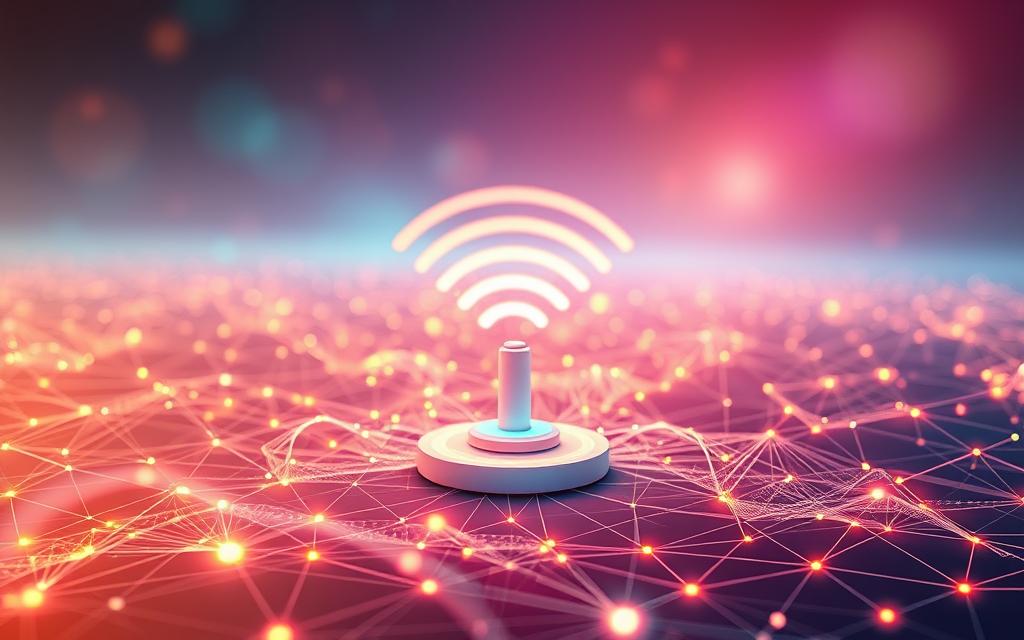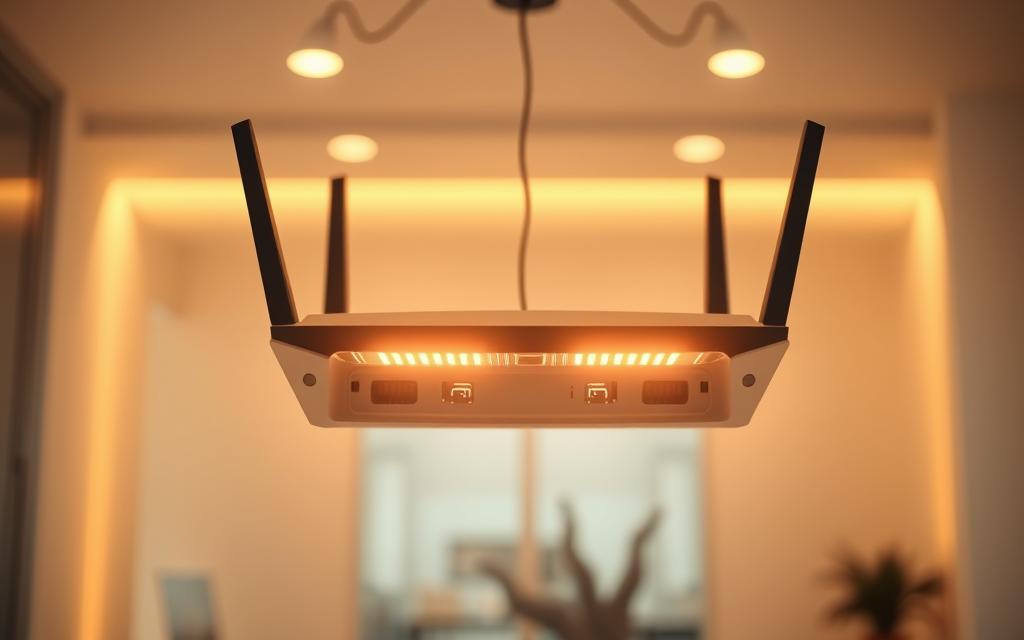Wireless communication has become a cornerstone of modern life. It allows devices like smartphones, laptops, and IoT gadgets to connect seamlessly. This network operates using radio waves, enabling users to access the internet without physical cables.
Managed by the Wi-Fi Alliance, this system follows IEEE 802.11 standards. These ensure compatibility and reliability across devices. Over 3.05 billion Wi-Fi-enabled units ship annually, showcasing its global adoption.
Understanding this wireless method matters. It bridges the gap between traditional wired connections and modern convenience. Whether for work or leisure, it keeps us connected in an increasingly digital world.
What is Wi-Fi? Defining the Technology
The evolution of wireless connectivity has transformed how we interact with devices. At its core, this system relies on radio waves to transmit data, eliminating the need for physical cables. Known for its widespread use, it operates across multiple frequency bands, including 2.4GHz, 5GHz, and 6GHz.
The Origins of Wi-Fi
The journey began in 1985 when the FCC released the ISM band for unlicensed use. By 1997, the first commercial application emerged, offering speeds of 2Mbit/s. Key contributions came from NCR/AT&T’s WaveLAN and CSIRO’s patented innovations, which earned $420M in settlements.
Apple played a pivotal role in popularizing this service. In 1999, the iBook became the first consumer laptop with built-in wireless capabilities, driving mass adoption. This marked a turning point, making wireless connectivity accessible to everyday users.
Wi-Fi vs. Other Wireless Technologies
Unlike Bluetooth, which focuses on short-range connections, Wi-Fi excels in broader coverage. It also differs from Li-Fi, which uses light for data transmission. Cellular networks, while powerful, often require more infrastructure and cost.
The name “Wi-Fi” was chosen for branding, though the technical term remains IEEE 802.11. This standard ensures compatibility across devices, from computers to smart home gadgets. Despite congestion issues, the 2.4GHz band remains popular due to its ability to penetrate walls and cover larger areas.
For more details on its development, visit this comprehensive guide.
How Does Wi-Fi Work? The Science Behind Wireless Communication
Understanding the science behind wireless communication reveals its true power. At its core, this system relies on radio waves to transmit data. These waves travel through the air, allowing devices to connect without physical cables.

Radio Waves and Data Transmission
Wireless communication uses orthogonal frequency-division multiplexing (OFDM) to send data efficiently. This method divides the signal into multiple smaller channels, reducing interference and improving speed. Older systems used DSSS, but OFDM has become the standard for modern networks.
The frequency bands play a crucial role. The 2.4GHz band offers better range, while the 5GHz band provides faster speeds. Wi-Fi 6, the latest standard, achieves up to 9.6Gbit/s under ideal conditions.
The Role of Routers and Access Points
Routers act as the central hub for wireless networks. They manage traffic, translate addresses, and ensure data reaches the right device. Access points extend coverage, making them essential for larger spaces.
Deploying multiple access points can eliminate dead zones. Environmental factors like walls and furniture can weaken the signal, but MIMO technology helps by using multiple antennas to boost throughput.
| Frequency Band | Range | Speed |
|---|---|---|
| 2.4GHz | Longer | Slower |
| 5GHz | Shorter | Faster |
Mesh networks are another option, using multiple devices to create a seamless connection. This setup is ideal for homes or offices with complex layouts. By understanding these components, users can optimize their wireless experience.
Is Wi-Fi Technology? Breaking Down the Basics
Wireless networks have reshaped how we stay connected. These systems rely on radio waves to transmit data, enabling seamless communication across devices. From smartphones to smart home gadgets, they form the backbone of modern connectivity.
Wi-Fi as a Networking Technology
Wi-Fi operates as a network technology, allowing multiple devices to share data without physical cables. It uses radio frequencies to create a wireless local area network (WLAN). This setup provides flexibility and convenience, making it ideal for both home and enterprise use.
One key feature is its ability to handle high speed data transfer. Wi-Fi 6, for example, supports 8K streaming and VR applications. This advancement ensures smoother performance, even in crowded environments.
The IEEE 802.11 Standards
The IEEE 802.11 standards define how Wi-Fi functions. These protocols ensure compatibility across devices, from laptops to IoT gadgets. Backward compatibility is maintained through versions like 802.11a/b/g/n/ac, allowing older devices to connect seamlessly.
Wi-Fi 6E introduces a 160MHz channel width, reducing congestion and improving access. This innovation enhances the user experience, especially in areas with multiple connected devices. By adhering to these standards, Wi-Fi continues to evolve, meeting the demands of modern connectivity.
The Benefits of Wi-Fi: Why It’s Essential Today
Wireless networks have revolutionized the way we live and work. They provide seamless access to the internet, enabling multiple devices to connect effortlessly. From homes to businesses, these systems have become a cornerstone of modern connectivity.

Convenience and Mobility
One of the biggest advantages is the freedom it offers. Unlike wired systems, wireless networks eliminate the need for physical cables. This allows mobile devices to stay connected, whether at home or on the go.
Public hotspots are a prime example. By 2026, their number is projected to reach 628 million globally. This growth ensures that users can stay connected almost anywhere, enhancing productivity and convenience.
Cost-Effectiveness and Scalability
Wireless systems are also highly economical. They eliminate cabling costs, which can average $150-$200 per Ethernet drop. This makes them a budget-friendly option for both individuals and businesses.
Scalability is another key benefit. Mesh systems, for instance, enable whole-home coverage, ensuring a strong connection in every corner. This flexibility makes wireless networks ideal for growing households or expanding enterprises.
In corporate environments, 89% of enterprises support BYOD policies, thanks to wireless systems. This trend not only reduces costs but also boosts employee satisfaction and productivity.
Types of Wi-Fi Connections: From Home Networks to Public Hotspots
From home setups to public areas, wireless connections dominate daily life. These systems provide seamless access to the internet, enabling multiple devices to stay connected. Whether in a living room or a coffee shop, they play a vital role in modern connectivity.

Home Wi-Fi Networks
In the United States, 72% of households rely on wireless routers for internet access. These setups vary, with single-router systems being the most common. However, mesh systems are gaining popularity for their ability to cover larger areas.
Choosing the right network setup depends on the area and usage. Single routers work well for smaller spaces, while mesh systems eliminate dead zones in larger homes. Optimal channel selection can also reduce interference, especially in urban settings.
Public Wi-Fi and Its Challenges
Public hotspots offer convenience but come with risks. Hacking incidents increased by 87% between 2020 and 2023, highlighting the need for security measures. Captive portals, used for authentication, are common in coffee shops and hotels.
Using a VPN on public networks can protect sensitive data. However, users must remain vigilant against threats like “evil twin” attacks, where hackers mimic legitimate networks. Hotel networks often throttle speed, but municipal Wi-Fi projects show promise in providing reliable access.
| Feature | Home Networks | Public Hotspots |
|---|---|---|
| Coverage | Single router or mesh system | Limited to specific area |
| Security | Controlled by user | Higher risk of attacks |
| Speed | Consistent, customizable | Often throttled |
Wi-Fi Security: Protecting Your Data
Ensuring the safety of your wireless connection has never been more critical. With the increasing reliance on wireless networks, safeguarding sensitive data is a top priority. From personal devices to enterprise systems, robust security measures are essential to prevent breaches and unauthorized access.
Common Wi-Fi Security Threats
One of the most notable threats is the KRACK attack, which exploits vulnerabilities in the 802.11 handshake. This can compromise the connection between your device and the network. Additionally, 63% of IoT device hacks originate through wireless networks, highlighting the need for stronger security protocols.
Deauthentication attacks are another concern. These disrupt the signal between devices and routers, forcing reconnections that hackers can exploit. Understanding these threats is the first step toward better protection.
Best Practices for Secure Wi-Fi Usage
Adopting WPA3 encryption is a game-changer. By 2023, 41% of enterprise networks had implemented this standard, which offers enhanced security features. For individual users, updating firmware regularly ensures vulnerabilities are patched promptly.
Using a VPN on public networks adds an extra layer of protection. It encrypts your data, making it harder for hackers to intercept. Segmenting IoT devices from your main network also reduces risks, as it limits potential entry points for attackers.
Finally, enabling 802.1X authentication in enterprise setups ensures only authorized users can access the network. These strategies collectively strengthen your wireless security, keeping your data safe from harm.
Wi-Fi in Everyday Life: Applications and Uses
Wireless connectivity has seamlessly integrated into daily routines. From smart homes to corporate offices, it powers countless activities. This network ensures smooth communication, enabling devices to function efficiently.

Wi-Fi in Smart Homes
The average smart home now hosts 25 connected devices. These include smart speakers, thermostats, and security systems. Whole-home audio systems rely on robust connections to deliver seamless sound across every room.
Wi-Fi 6 plays a pivotal role in 8K video distribution. Its advanced capabilities ensure smooth streaming, even for high-resolution content. This makes it ideal for modern entertainment setups.
Wi-Fi in Business and Education
In the business world, Wi-Fi 6 adoption surged by 182% between 2021 and 2023. Enterprises leverage it for warehouse inventory management, ensuring real-time tracking and efficiency. Retailers use it for foot traffic analytics, optimizing store layouts.
Educational institutions benefit from 802.11ax, enabling AR/VR classroom applications. University campuses deploy extensive network coverage to support thousands of users. Hospitals also rely on wireless systems for IoT devices, enhancing patient care.
As the metaverse gains traction, wireless access will become even more critical. It will support immersive experiences, shaping the future of connectivity in every area of life.
The Evolution of Wi-Fi: From 802.11 to Wi-Fi 6
The journey of wireless communication has evolved dramatically over the decades. Starting with the first 802.11 standard in 1997, which offered a modest 2Mbps, the network landscape has transformed significantly. Today, Wi-Fi 6 delivers speeds up to 9.6Gbps, showcasing the remarkable progress in speed and efficiency.
A Brief History of Wi-Fi Standards
The 802.11a standard introduced in 1999 marked a leap forward, utilizing the 5GHz frequency band for faster data transfer. By 2003, 802.11g combined the best of both worlds, offering compatibility with older devices while improving range and performance.
Wi-Fi 4 (802.11n) brought MIMO technology, enhancing network capacity. Wi-Fi 5 (802.11ac) further boosted speeds, making it ideal for high-bandwidth applications. Wi-Fi 6 (802.11ax) introduced OFDMA, reducing latency and improving access in crowded environments.
What’s Next for Wi-Fi Technology?
Wi-Fi 7 (802.11be) is on the horizon, promising speeds up to 46Gbps. Its multi-link operation allows simultaneous use of multiple frequency bands, ensuring seamless connectivity. The 6GHz band, introduced in Wi-Fi 6E, adds 1200MHz of spectrum, reducing congestion and enhancing performance for VR/AR applications.
Future advancements like Wi-Fi 8 (802.11bn) aim for terabit speeds, while THz spectrum exploration could revolutionize wireless communication. AI-driven network optimization and quantum encryption are also expected to play pivotal roles in shaping the next generation of wireless technology.
Wi-Fi and the Internet of Things (IoT)
The Internet of Things (IoT) thrives on seamless wireless connections, transforming how devices interact. From smart homes to industrial automation, these systems rely on robust networks to function efficiently. Wi-Fi plays a pivotal role in enabling this connectivity, ensuring access to data and services across a wide range of applications.
How Wi-Fi Powers IoT Devices
Wi-Fi HaLow (802.11ah) extends the range of IoT devices up to 1km, making it ideal for agricultural sensor networks and smart city applications. This standard reduces interference and enhances signal reliability, even in challenging environments. Additionally, Wi-Fi 6 introduces Target Wake Time, optimizing battery life for IoT devices by minimizing unnecessary power consumption.
Protocols like Zigbee and Z-Wave offer alternatives, but Wi-Fi remains the preferred choice due to its widespread adoption and compatibility. The Matter standard further unifies 65% of smart home devices, ensuring seamless integration across brands. These advancements highlight Wi-Fi’s critical role in powering the IoT ecosystem.
The Future of Wi-Fi in IoT
By 2025, 42 billion IoT devices will require reliable connections, driving innovation in wireless technology. Wi-Fi 7 is set to revolutionize autonomous vehicle grids, offering ultra-low latency and high throughput. Passive Wi-Fi backscatter techniques are also emerging, enabling energy-efficient communication for IoT devices.
Satellite-Wi-Fi convergence is another promising development, extending network coverage to remote areas. As IoT continues to grow, these advancements will ensure that Wi-Fi remains at the forefront of modern connectivity, shaping the future of smart devices and applications.
Challenges and Limitations of Wi-Fi Technology
Modern wireless systems face unique challenges that impact performance. From interference to limited range, these issues can affect the quality of your connection. Understanding these constraints helps users optimize their network for better results.
Interference and Range Issues
One major challenge is interference, especially in crowded environments. The 2.4GHz band, for example, has only three non-overlapping channels. This often leads to co-channel interference in apartment complexes, where multiple devices compete for the same signal.
Range limitations also pose a problem. Millimeter wave absorption can reach 16dB/km in rainy conditions, weakening the signal. Even in ideal settings, walls and furniture can reduce the effective range of wireless systems.
Bandwidth and Speed Constraints
Bandwidth and speed are critical factors in wireless performance. Multi-user efficiency peaks at 75% in dense deployments, meaning not all devices receive optimal speed. Thermal throttling in consumer routers further exacerbates this issue, reducing performance during prolonged use.
Packet loss in congested environments is another concern. Hybrid Li-Fi/Wi-Fi solutions are emerging to address these limitations, offering faster speed and reduced interference.
| Challenge | Impact | Solution |
|---|---|---|
| Interference | Reduced signal quality | DFS channel optimization |
| Range | Limited coverage | Mesh network deployment |
| Speed | Lower throughput | Wi-Fi 6 adoption |
Conclusion: The Role of Wi-Fi in Modern Communication
The seamless integration of wireless networks into modern infrastructure has transformed global communication. Today, these systems carry 62% of global IP traffic, underscoring their importance in daily life. From homes to businesses, they enable access to the internet, powering billions of devices worldwide.
Looking ahead, the convergence of 5G and Wi-Fi is expected in 98% of devices by 2028. Innovations like Wi-Fi 7 and terahertz band research promise faster speeds and enhanced connectivity. Security remains a critical factor, driving adoption and ensuring safe access for users.
As wireless systems evolve, they will continue to shape the future of digital communication. Embracing these advancements ensures a more connected and efficient world. Now is the time to adopt and optimize this essential technology.










